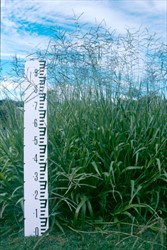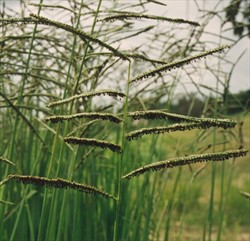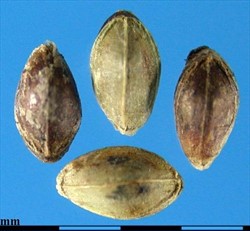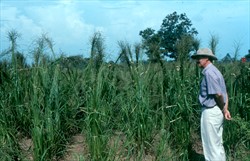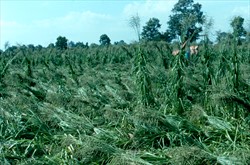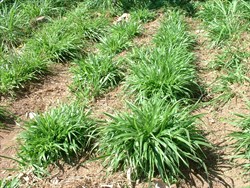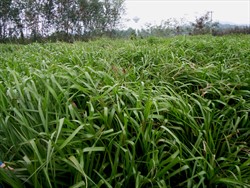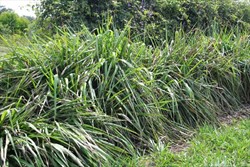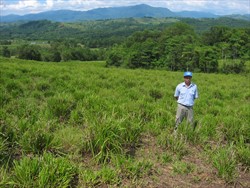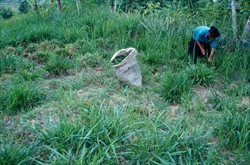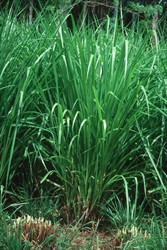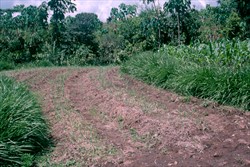Tropical Forages
None listed in GRIN.
Family: Poaceae (alt. Gramineae) subfamily: Panicoideae tribe: Paspaleae subtribe: Paspalinae group: Plicatula.
A leafy upright, rhizomatous perennial tussock grass, usually less than 1.0 m tall, to 2 m when in flower. Sheaths broad, loose, keeled, the lower ones crowded towards the base, the upper ones elongate, nearly reaching the base of the panicle, glabrous or a few long hairs on the margins towards the summit; ligule 1–2 mm long, hidden in the sheath; leaf-blades elongate, 35–65 cm long, 7– 20 mm wide, shiny and brittle, even when mature; leaf margins very scabrous; leaf hairiness varies with provenance. Seed borne in a simple panicle to 26 cm long comprising up to 20 rather narrowly ascending racemes, the lower ones to 14 cm long. Spikelets about 3 mm long and 2 mm wide, elliptic, slightly obovate, glabrous; 1 basal sterile floret and 1 fertile floret, second glume and sterile lemma covering the caryopsis, the lemma raised in a definite hump; caryopsis reddish-brown, shining, minutely striate. 250,000‒450,000 seed units per kg.
Asia: atratum, Ubon paspalum (Laos, Thailand)
English: atratum, atra paspalum (USA)
Latin America: capim-pojuca (Brazil); pasto pojuca (Venezuela), pasto cambá (Argentina)
Native:
South America: Brazil (Goiás, Mato Grosso and Minas Gerais states), Bolivia (Santa Cruz).
Cultivated:
Now used as a sown forage or hedgerow in areas extending from near the equator (southeast Asia) to the subtropics of Australia, USA and South America.
Forage
Used as a long-term pasture in the open and under trees. Upright habit and ease of cutting make it useful in cut-and-carry systems, although the sharp leaf edges can cause discomfort to the handler. Shows early promise for hay making.
Environment
Erosion control when used in hedgerows. Popular as a hedgerow for erosion control but tends to compete more vigorously with adjacent crop rows than does the non-forage vetiver grass, Chrysopogon zizanioides.
Soil requirements
Successful on soils ranging from sands to clays; can tolerate poorly drained, acid, low fertility conditions. Responds to nitrogen fertilization.
Moisture
Mostly occurs in areas with rainfall 1,500‒2,000 mm/yr where it is usually found in depressions which have a high water table and are subject to waterlogging and periodic flooding. Does not grow in permanently inundated areas.
In cultivation, it will persist with about 1,100 mm/yr, but is best with over about 1,500 mm. Prefers moist, well- or poorly-drained soils. Although not as drought tolerant as Urochloa decumbens or survives dry conditions reasonably well. Very tolerant of flooding but does not grow in permanent water.
Temperature
Occurs between about 14º S in Bolivia and 20º S in Brazil, to 600 m asl. These areas have an average annual temperature of about 23 ºC. However, it has adapted to areas with average annual temperatures as low as 20 ºC, but is best grown between about 22 and 27 ºC. is primarily a warm season grass, having limited cool season growth. Tops are killed by frost, but plants recover quickly with onset of warm conditions.
Light
Moderate to good shade tolerance; useful in agroforestry.
Reproductive development
Flowering in the first year may be minimal, but thereafter, commences early April (southern hemisphere) or October (northern hemisphere) in the subtropics, and earlier at lower latitudes. Within 5‒10º of the equator, flowering may cease altogether. Flowering is disrupted if the stand is cut or grazed low within 2 months of commencement of flowering, destroying the elongating apical meristem. Seed tends to be shed as soon as it matures (shatters).
Defoliation
Tolerant of low grazing and regular cutting, although best results obtained from more lenient management. Should not be allowed to become mature. Very easy to cut with scythe or mower. For grazing, rotations with 20‒40 days rest periods are recommended.
Fire
Fire is not normally an issue where is grown, but on the rare occasion that stands may be burnt, plants recover rapidly.
Guidelines for establishment and management of sown forages.
Establishment
Reports of dormancy levels in fresh seed vary from low to quite high, but, even with dormant seed, germination reaches acceptable levels after 3‒4 months. Germination of fresh seed can be improved from about 20% to nearly 100% by removal of the lemma and palea. Seed has a very limited 'shelf life' under ambient conditions, and may remain viable for less than a year. Seed storage for several years should be at low temperature and low relative humidity. Seed is normally sown at 2‒5 kg/ha, either broadcast or in 0.5‒1 m rows. Establishes rapidly from seed, or from rooted tillers.
Fertilizer
Survives at low fertility but responds to nitrogen applications of the order of 150‒200 kg N/ha/yr.
Compatibility (with other species)
Can compete with aggressive species such as Paspalum notatum cv. Pensacola, even under heavy grazing. Due to its moderate shade tolerance, it can be grown under trees.
Companion species
Grasses: Best not planted with other grasses, although may combine with Setaria sphacelata in some situations.
Legumes: Arachis pintoi, Calopogonium mucunoides, Grona heterocarpa ssp. ovalifolia, Neustanthus phaseoloides.
Pests and diseases
In Florida, armyworms can be a problem later in the growing season, and some mole cricket damage has occurred. A leaf spot (Helminthosporium sp.) has been recorded on older leaves. Severe leaf spot has been noted in Brazil. Spittlebug has not been a problem. No record of nematode damage.
Ability to spread
No vegetative spread, but will spread by seed if allowed to mature late in the season. However, if grazed or mowed within 100 days of flowering, seed set is minimised.
Weed potential
has been assessed as a weed in some areas due to the misconceptions that it is a 'water grass' and that it develops a soil seed bank. However, it does not grow in inundated situations and seed does not survive for extended periods in the soil.
Nutritive value
IVDMD range reported is 40‒68%; CP concentrations reported are rather low and depend on soil fertility (e.g. 5.9‒7.9% in 30 days old plants); P concentration 0.30%.
Palatability/acceptability
Well eaten by cattle, sheep, buffaloes, horses, fish, and pigs. Herbage older than 50 days in the wet season and 70 days in the dry season becomes unpalatable to cattle.
Toxicity
No record of anti-nutritional factors.
Tetraploid (2n = 4x = 40); apomict.
There is little flowering in the first year in plants established after June (northern hemisphere) or January (southern hemisphere). In the second year, stock should be removed or a cleaning cut given at least 100 days prior to harvest to avoid damage to elongating apical meristem. Seed crops are usually ready for harvest about 4 weeks after flower emergence. Can produce up to 230 kg seed/ha, but in practice, a harvest of 100 kg/ha of dried and cleaned seed is realistic. Crops should be monitored closely to pick the precise time for harvest, since ripe seed is readily dislodged from the head. Well-fertilized seed crops are bulky and tend to lodge (fall over) making harvesting difficult. Seed should be dried to, and maintained at <10% moisture content if it is to stay viable for any period of time. P. atratum seed absorbs atmospheric moisture very readily and should ideally be stored in plastic-foil composite bags, not in porous bags.
Seedlings are damaged by 2,4-D, but not by dicamba at 0.5 kg AI/ha. Pre-emergence applications of clomozone, fluometron, diuron, imazetnapyr, metribuzin, trifluralin, and norflurazon prevent establishment from seed. Mature stands can be largely controlled using glyphosate at 3‒4 kg AI/ha. If spray water contains high concentrations of antagonistic calcium and magnesium salts (see herbicide label), the addition of ammonium sulphate at 10 kg/ha, with glyphosate at 2 kg a.i./ha, may improve kill.
- Easy to sow and quick to establish.
- Adapted to wet, acid soils.
- Tolerant of temporary flooding.
- Palatable to cattle, horses and sheep when young.
- Tolerates low grazing.
- Suitable for cut and carry.
- Only moderate nutritive value.
- Limited to moist situations.
- Unpalatable when mature.
- Seedlings susceptible to 2,4-D.
Acuña, C.A., Martínez, E.J., Zilli, A.L., Brugnoli, E.A., Espinoza, F., Marcón, .F, Urbani, M.H. and Quarin, C.L. (2019) Reproductive systems in Paspalum: Relevance for germplasm collection and conservation, breeding techniques, and adoption of released cultivars. Frontiers in Plant Science. 10: 1377. https://doi.org/10.3389/fpls.2019.01377
Filgueiras, T.S. and Rodrigues, R.S. (2016) Paspalum atratum (Capim-pojuca). In: Vieira, R.F., Camillo, J. and Coradin, L. (eds) Espécies Nativas da Flora Brasileira de Valor Econômico Atual ou Potencial: Plantas para o Futuro ‒ Região Centro-Oeste. Secretaria de Biodiversidade, Ministério do Meio Ambiente, Brasília, DF, Brazil. p. 655‒658. https://bit.ly/2UMZUzo
Hare, M.D., Saengkham, M., Kaewkunya, C., Tudsri, S., Suriyajantratong, W., Thummasaeng, K. and Wongpichet, K. (2001) Effect of cutting on yield and quality of Paspalum atratum in Thailand. Tropical Grasslands 35:144–150. bit.ly/3dLytNK
Kalmbacher, R.S., Brown, W.F., Colvin, D.L., Dunavin, L.S., Kretschmer Jr., A.E., Martin, F.G., Mullahey, J.J. and Rechcigl, J.E. (1997) 'Suerte' atra paspalum: Its management and utilization. Circular S-397. University of Florida, Gainesville, FL, USA. bit.ly/3bxufHQ
Kalmbacher, R.S., Martin, F.G. and Kretschmer Jr., A.E. (1997) Performance of cattle grazing pastures based on Paspalum atratum cv. Suerte. Tropical Grasslands 31:58–66. bit.ly/340sy3d
Kalmbacher, R.S., West, S.H. and Martin, F.G. (1999) Seed dormancy and aging in atra paspalum. Crop Science 39:1847–1852. doi.org/10.2135/cropsci1999.3961847x
Marcón, F., Urbani, M.H., Quarin, C.L. and Acuña, C.A. (2018) Agronomic characterization of Paspalum atratum Swallen and P. lenticulare Kunth. Tropical Grasslands-Forrajes Tropicales 6(2):70–81. doi.org/10.17138/tgft(6)70-81
Oliveira, R.C. and Valls, J.F.M. (2008) Novos sinônimos e ocorrências em Paspalum L. (Poaceae) Hoehnea 35(2): 289-295 http://dx.doi.org/10.1590/S2236-89062008000200010
Quarín, C.L., Valls, J.F.M. and Urbani, M.H. (1997) Cytological and reproductive behavior of Paspalum atratum, a promising forage grass for the tropics. Tropical Grasslands 31:114–116. bit.ly/3axEhbT
'Suerte' (Florida, USA 1995), 'Hi-Gane' (Australia 1995), 'Camba FCA' (Corrientes Argentina 1997), 'Terenos (South-east Asia ~1995), 'Ubon' (Thailand 1997), 'Reyan No. 11' (China 2003), 'Pojuca' (Brazil 2004) (BRA 009610, ATF 2013, VSW 9880, IRFL 658). Origin Terenos, 30 km west of Campo Grande, Mato Grosso do Sul, Brazil (20°27' S, 414 m asl, rainfall 1,430 mm). A largely glabrous, broad-leafed provenance formally or informally commercially released across several countries and regions between 1990 and 2005.
BRA 011681 Origin São Paulo, Brazil – more productive and higher quality than BRA 009610, which is the accession commercialised across the tropics (under names such as 'Suerte'; see Cultivars).
BRA 009661 Origin Amazonian Amapá, Brazil – high dry matter production and quality.
BRA 010537 Origin Cáceres, Mato Grosso do Sul, Brazil. Preferentially grazed over 4 other P. atratum accessions, including BRA 003913 and BRA 009661, in Corrientes, Argentina.
